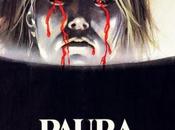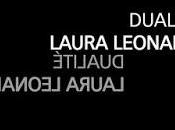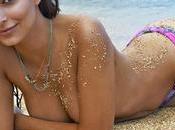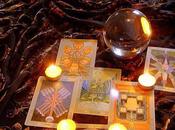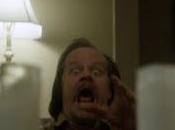Coreografia d’Arte: from 24 to 30 november 2012 (dates are subject to change)
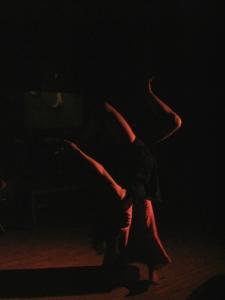
Enliberté, Coreografia d'Arte 2009
Coreografia d’Arte, in its next edition – the third – investigates space.
Not just space as a choreographic, physical and conceptual element, intrinsic to the art of choreography and to art in general, but as a greater element: natural, day-to-day, psycho-physiologic, socio-cultural, civil, political and, above all, artistic.
Space as a question, and one that is still open, from which we build the research and creativity every kind of art and artistic activity is made of: painting, sculpture, photography, cinema, literature.
Space, body and power. This we want to investigate and research, from here we want to start.
The space of a theatrical scene is the space of a work of art, of a painting, of a block of stone, of a photographic or cinematographic lens. It is the perimeter of a conflict. Of the transfer of a limit. It is the space of the research of freedom.
The idea that spatiality is a formative activity “because of it being an abstract structure that directs our attributions of sense” (Lotman and Greimas), too, is in on the same wavelength with the choreographic approach to a space that is also abstract, a space in which the levels of sense orient and define themselves also starting from use, investing – or not – the spatial articulation with meanings and/or values that can be different from the ones that are purely functional and built on the relationship with movement.
It is on the same wavelength with Coreografia d’Arte will to face the investigation, the research, precisely as a laboratory of ideas, signifieds and signifiers.
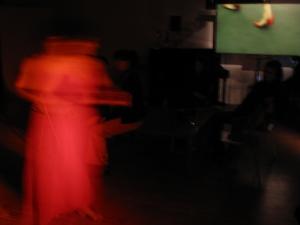
Enliberté, Coreografia d'Arte 2009
In the plurality of meanings we may refer to in dancing and in art in general when we talk about space (the space of the single dancer, the one of the dancers as a whole, the choreographic/theatrical space and the space/environment in which the performance is set), we want to become immersed in the other shapes that spatiality can adopt, not only in respect to the outside of the body, but also to the inside.
We would like dancing and art to compare with the series of virtual spaces proposed by technologies – IT and not – and new media, not as a medium with which to open a dialogue and interact, but as supports that, according to the concepts that are peculiar to the screen, have probably erased the corporeity and the physical aspects of relationships, and the physical space of relationships, of whishes, actions, thoughts, dialogue. Has the body changed through these supports and virtual spaces? How much? How much can this transformation have erased, together with the body and its space, the space of the “self”?
And there is more. Dancing becomes writing. Does it become capable of a real “engraving”, on a statuesque ground? We are before a space that, giving shape and being given shape in return, acquires so much concreteness and density that it cannot assume the form of an “empty space” anymore (Peter Brook, The Empty Space, 1968).
Space represents a dynamic force in the contemporary conflict about meaning, belonging and power. Jody Berland, Space 2005.
Let’s become immersed in this analysis and research.
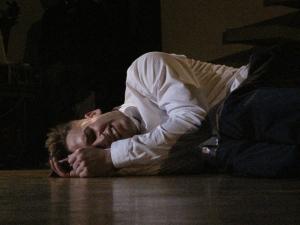
He doesen't love, Riki Bonsignore, Coreografia d'Arte 2009
Martin Heidegger, in his text “Art and Space”, identifies space as a “primitive” phenomenon, which also provokes a sort of “fear”. It presents itself as the limit, as what one cannot go beyond: a challenge to language and to thinking. The notion of space has an evocative power, it makes other concepts come to mind: the concept of making free, of creating a void in which something can happen, of an event. And the true in art, according to Heidegger, is not an experience that asserts itself over man as the evidence of objects does, it is a more delicateencounter, more connected to atmosphere than to presence: a concurring and convening of occasions. The German philosopher sees in the work of art the opening of truths. Art itself brings in categories of comprehension, conceptual principles, definitions which orientate existence.
That is why art comes before truth: because, by founding a certain language, by defining a certain horizon, it is the origin of truth. To Heidegger, moreover, art is involved in a direct confrontation with space. As is quoted in his book, “the way in which space holds up and passes through the work of art remains, for the moment, in the undetermined.”. The title originally chosen by Heidegger itself, “Space, man, language”, connects art and language together in an unconventional way.
And it is in an unconventional way that Coreografia d’Arte wants to investigate and connect art, choreography, dancing, language, space, body and power.
Books, essays, manuals still write about choreographic composition as the art of choreography in space, the art of writing dancing into space.
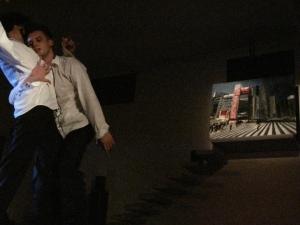
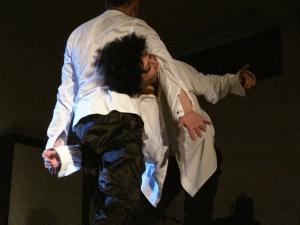
Naburi, Coreografia d'Arte 2009
- Naburi, Coreografia d’Arte 2009
Great choreographers of the 20th century have dealt with the problem of space. Balanchine inspires director Robert Wilson about the creation of a space that is both physical and mental; Graham , Humphrey, Limón, Ailey give to space a specific weight and a statuesque solidity by exalting some “strong points” and, with them, the characters and the viewer’s attention, and space loses its “neutral” value to become a field of contrasting forces inside which the opposing nature of dancing, with its conflicting pushes and tensions – contraction and release according to Graham, fall and recovery to Humphrey – must be given evidence.
The choreography of the 1950s and 1960s deals with the problem of space. The choreographers of the so-called “American New Dance”, Nikolais, Taylor, especially Cunningham, pulverise the certainties of modern dancing and project the dancing individual into cosmos, dealing with technology, science and the necessary re-thinking of the way of the art of movement itself.
The Renaissance perspective falls, the bodies of the dancers are lost in a space in which there are no poles of attraction more, the face-to-face relationship between dancers and public (Cunningham) is broken, the need of getting the show out of theaters, into art galleries, streets, squares and museums, begins to be felt as an urgent one. The relationship with space keeps the post-moderns busy as well, with the help of music and set decoration – this one frequently assigned to famous visual artists.
The last quarter of the century brings in the compositional ways of the Neo-expressionist choreography, Tanztheater, in which Cunningham’s deflagration of space coincides with a rip and a fragmentation of gestures, actions, music, words and dancing to which only the art of choreographic composition can give rhythm, shape and structure.
Ways in which the space of the dancers’ improvising, which is so essential, is introduced.
A matter that is alive, unstable, provocative, capable of changing the course and the space of a predefined choreography. In this space, which is not just a physical problem anymore, but more of a mental, an intellectual, an emotional, a signifying one, words and gestures are written by choreographers “of expression” like Pina Bausch, and choreographers of shape like Forsythe, who state and make so that the art of choreography in space is a significant and transparent act of writing, universally and immediately readable as a story set into space, if the choreographer puts some thought in it.
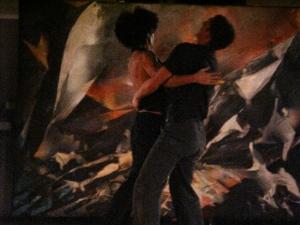
La Medusa delle Periferie, Coreografia d'Arte 2009, Opera di Gabriele Poli
The relationship between space, gesture and dynamics. Dynamics in space and of space. Countless varieties of plots set in space. The grain of a surface in painting, the colour, the mixture, the layering, the intensity; the timbre in music, the smooth and sharp movement in dancing; the core of the so-called dead center/ absolute center, the background and the forestage, the strong areas and the weak ones, the invisible diagonals created by the eye in the theatrical space; the symmetrical or asymmetrical arrangement, choreographic sections, full dances, rhythms and rhythm’s perceptible oscillations, the sentences in the choreographic composition. The social space and the mood of our time, which is reflected on every human behavior, the choreographer’s feelings and tastes included.
The space of the visual influences: architecture, modern cities, the almost complete absence of landscape, sculpture, ornament. The space of the active consciousness of the possible forms of expression; the space of lines, of shapes and of the subject. Of doubt, of strength, and of conflict. Choreography is the research of space, like the attempt to define in which relationship one is with the time he lives in.
The space of imagination, of inspiration, of the dexterity in improvising, of the poetic and musical sensitivity; the space of the body, a tool that is more practical and tangible, maybe, than words, than musical notes and than colours; the space of the structure of the body, of levers, of nerves, of muscles, of personality. The contradictory space of research and production. The space of art, as relationship, as vehicle, the place of welcoming – actors mingled with the public – as Peter Brook states in his essay “From Timon of Athens to The Tempest, or, The director and the circle”.
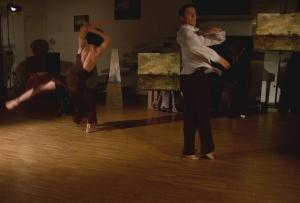
Naked, Coreografia d'Arte 2009
These are only some of the starting points from which we take wonderings, questions, ideas, traces and paths on space. Questions and theoresis which are complex but intriguing, and rightful maybe, to choreography and to art.
To reach a stronger and deeper relationship with the languages of art and to care for knowledge is an essential expression of every society. And it is the sort of care that Coreografia d’Arte feels.
Here is where the new edition is born from. From a thought that may open new reflections on space, and from a dancing in space that is born from a thinking choreographer who reveals his aesthetics and his Weltanschaung (vision of the world) in the choreographic writing. Because Coreografia d’Arte doesn’t stop – and does do precisely through art – to remember the need to be witnesses of the contemporary, to chew a thought, to pour a thought, to communicate it.
In the past editions (2009 and 2010), too, it witnessed social and contemporary themes and matters.
Coreografia d’Arte’s soil is extremely fertile: painters, sculptors, photographers, writers, intellectuals, passionate viewers, choreographers and dancers, art critics and curators. That’s why we propose a source of investigation, of analysis, reflection and theoresis as challenging as space is.
Coreografia d’Arte was born from the convergence, the dialogue, the meeting and the communication of the arts.
And growing on this pathway of human and rightful communication, it now goes on in the equally rightful navigation in the “art of ideas”.
Federicapaola Capecchi, Francesco Tadini
Read the article in Italian Here

